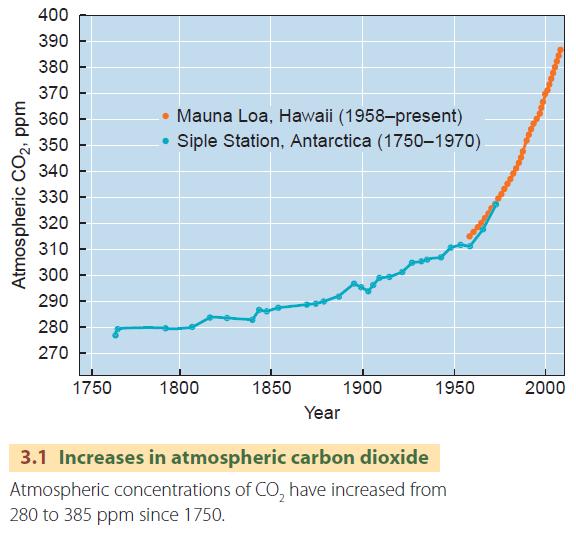Carbon Dioxide — On the Increase
One of the most important factors affecting air temperatures over the long run is the greenhouse effect, in which atmospheric gases absorb outgoing longwave radiation and reradiate a portion back to the surface. This makes surface temperatures warmer. Apart from water vapor, carbon dioxide gas plays the largest role in the greenhouse effect and CO2 concentration is increasing. In the centuries before global industrialization, carbon dioxide concentration in the atmosphere was at a level below 300 parts per million (ppm) by volume (Figure 3.1).
Since then, the amount has increased substantially to about 385 ppm. Why? When fossil fuels are burned, they yield water vapor and carbon dioxide. Water vapor does not present a problem because a large amount of water vapor is normally present in the atmosphere. But because the normal amount of CO2 was so small, fossil fuel burning has raised thelevel substantially. According to studies of bubbles of atmospheric gases trapped in glacial ice, the present level of about 385 ppm is the highest attained in the last 420,000 years and nearly double the amount of CO2 present during glaciations of the most recent Ice Age.

Even with future concerted global action to reduce CO2 emissions, scientists estimate that levels will stabilize at a value not lower than about 550 ppm by the late twenty-first century. This will nearly double preindustrial levels and is very likely to cause a significant increase in global temperatures.
Predicting the future buildup of CO2 is difficult because not all the carbon dioxide emitted into the air by fossil fuel burning remains there. Plants take up CO2 in photosynthesis to build their tissues, and under present conditions, global plant matter is accumulating. Phytoplankton in ocean waters also take up CO2, converting it into carbonate that sinks to the ocean floor. Together, these processes remove about half the CO2 released to the atmosphere by fossil fuel burning.
Another source of uncertainty is forecasting fossil fuel consumption. Future energy needs depend on global economic growth, which is difficult to predict, as well as the future efficiency of energy use. The amount of CO2 released also depends on the effectiveness of global action to reduce the rate of emissions through conservation and use of alternative energy sources.
Although there is a great deal of uncertainty about future atmospheric concentrations of carbon dioxide, one thing is certain. Fuel consumption will continue to release carbon dioxide, and its effect on climate will continue to increase.
- CERES—Clouds and the Earth’s Radiant Energy System
- Net Radiation, Latitude, and the Energy Balance
- The Global Energy System
- Sensible Heat and Latent Heat Transfer
- Composition of the Atmosphere
- Insolation over the Globe
- Electromagnetic Radiation
- The Ozone Layer— Shield to Life
- The Earth’s Revolution around the Sun